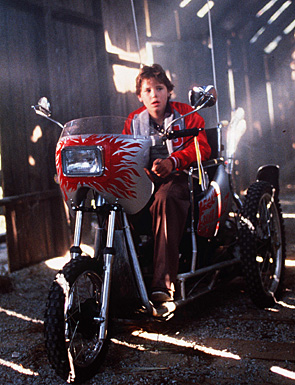[easyazon-image align=”left” asin=”B000063URC” locale=”us” height=”160″ src=”http://ecx.images-amazon.com/images/I/41SDMRH0M5L._SL160_.jpg” width=”110″]Based on Stephen King’s [easyazon-link asin=”0451822196″ locale=”us”]Cycle of the Werewolf[/easyazon-link], 1985’s [easyazon-link asin=”B000063URC” locale=”us”]Silver Bullet[/easyazon-link] imagines a young boy living with paralysis in a small Maine town being terrorized by a werewolf. Though it’s hardly the first time a horror movie has had a disabled character as its protagonist, they don’t usually come with souped-up wheelchairs as accessories. Marty rides around in an old chrome transport wheelchair indoors, but for outdoors his hard-drinking Uncle Red has tricked out a similar folding wheelchair with handlebars on the side containing the throttle for a gas-powered external motor. A license plate on the back reads “Silver Bullet”, covering a box that looks suspiciously like a battery case, though Marty must conspicuously run out of gas a couple of times to further the plot. (And endure “check the oil” jokes from the local gas station attendant. You can tell Stephen King isn’t terribly familiar with wheelchair users, because Marty reacts as if he’s never heard that joke before.)
Marty’s older sister considers him a burden and resents having some of his care thrust upon her, though the majority of the caregiving seems to be done by his overprotective mother. It seems to be Uncle Red who treats him like everybody else, telling him dirty jokes and teaching him to play cards to the chagrin of his mother. Red presents Marty with an even snazzier Silver Bullet rebuild one summer day, this one more closely resembling a motorcycle.
Eager to try out his new wheels, Marty climbs down the trellis outside his bedroom window on the night of July 4th to set off some illicit fireworks on a remote wooden bridge, where Marty first encounters the werewolf. He has the presence of mind to shoot a rocket into its eye, enabling his sister to identify the local reverend as the culprit when he suddenly starts sporting an eyepatch the next day.
Marty attempts to enlist the aid of the local police, but (as the book explains) the adults in his life decide he must have Post Traumatic Stress Disorder and is making up fantastical stories to cope with it. (In the book, Marty is then shipped off to live in Vermont to “recuperate”.) After another werewolf encounter in a barn (where the Silver Bullet runs out of gas again), Marty begins writing anonymous letters to the reverend, urging him to kill himself. This, plus the inherent bloodlust that comes with being a werewolf, slowly drives the reverend insane.
The werewolf attacks again on Halloween, first knocking out Uncle Red and then turning on the children. Marty stops him with the other kind of silver bullet, which not only removes the menace from the town but enables his sister to see him in a different light.
Wheelchair-accessible motorcycles are no longer the stuff of fiction; called “wheelchair tricycles”, they are available for purchase from several different companies. Several models even allow use without transferring from your chair.



